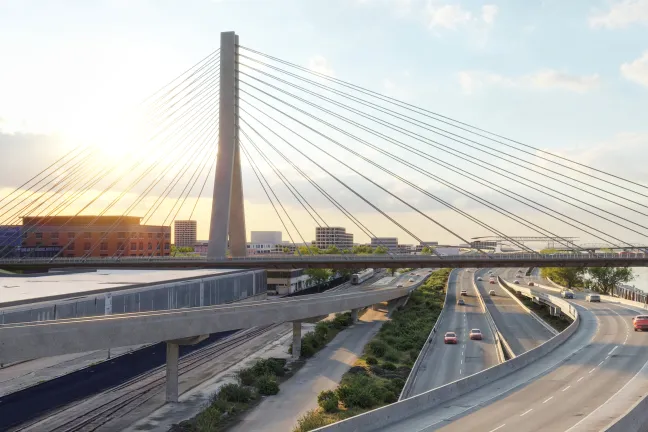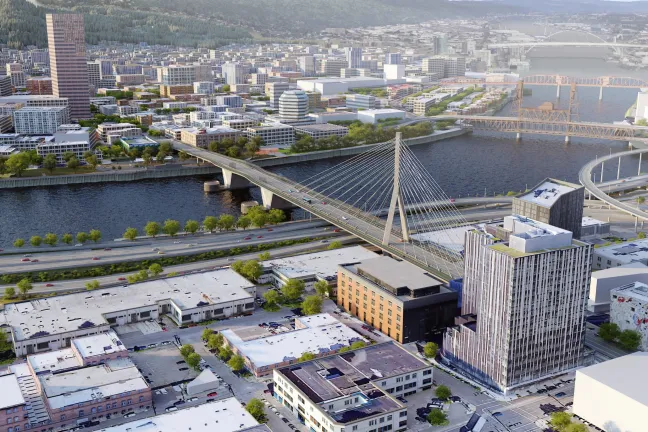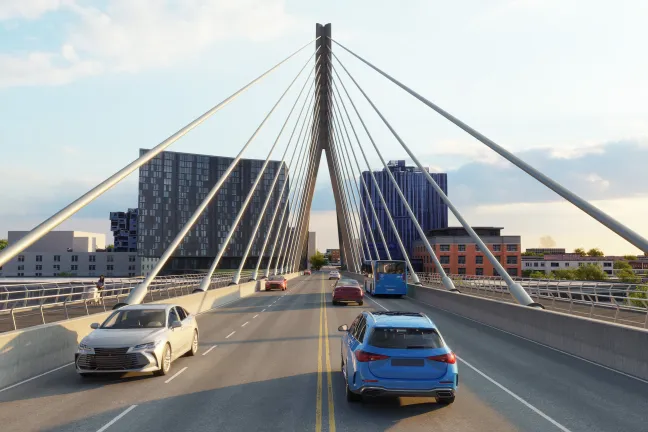At its board meeting Thursday, Sept. 12, the Multnomah County Board of Commissioners unanimously adopted a resolution to move forward with the inverted Y design option for the future look of the new Burnside Bridge. The new bridge will deliver significant value for all users. At 17 feet, the new Burnside Bridge will have the largest bike and pedestrian space of all downtown Portland bridges.
This marks a historic milestone for the Earthquake Ready Burnside Bridge Project which began in 2016.
“This is an iconic, long-lasting decision for our community and a major milestone for this critical project,” Chair Jessica Vega Pederson said. “I want to thank the overwhelming number of people who’ve joined this process and helped us take this next important step. Portland is shaped by our bridges and your energy met this moment.”
The inverted Y design is a triangular-shaped cable stay tower that extends to a single column. The design will be on the east side of the bridge, serving as a gateway in and out of downtown Portland. The cables will cascade from the tower down to the bridge creating a cohesive transition from the east side to the remainder of the bridge. For a look at how the inverted Y will fit into the urban landscape, you can watch this video.
“Deciding on a safe, sustainable bridge design is a critical decision of our Board,” Commissioner Lori Stegmann said. “I appreciate the members of the public who took time to share their thoughts through the public survey, and the dedication of the CDAG and the effort they put into their informed decision. I supported the inverted Y design because of the importance of having a visual icon in the event that our community becomes unrecognizable during a catastrophic event and the lower maintenance costs in the long-term.”
“Like Commissioner Stegmann, I look at bridges everywhere I go,” Commissioner Sharon Meieran said. “They stand out, they do mean something. This bridge project has spanned my career on the Board and I am proud of the result.”
“This bridge matters so much for our future safety and prosperity,” Commissioner Jesse Beason said. “That’s why thousands of residents weighed in on what they hope for the new Burnside Bridge—and 20 volunteers from all walks of life spent hours diving into the details. No matter what my eyes may prefer, I have not studied bridge design for years nor spent months in meetings discussing the intricacies and debating the choices. This is why we ask the experts and volunteers to advise us. And I am excited to follow their advice.”
"I'm supportive of moving forward with the recommended design because it is much needed infrastructure, and the design meets the most important criterion which is that it be earthquake resilient,” Commissioner Julia Brim-Edwards said. “As an eastsider who has worked on the west side and who crosses the river often on a daily basis, this will be a vital transportation link between the east and west side of our County. I'll continue to monitor, engage and push for aggressive cost management and control, so we deliver this essential life line in a cost-efficient way for the community."
Commissioners weighed a number of data points before the vote: the project’s public survey results, the Community Design Advisory Group’s recommendation and the County staff recommendation.
Summer public outreach
This summer, the project launched an online survey, which asked for community input on the future look of the new Burnside Bridge The County considered three cable stay and three tied arch options of various sizes for the east side of the bridge. Before taking the survey, the public had the opportunity to learn about all of the bridge type options by using interactive graphics and watching 3D videos that simulate the experience of being on and near the bridge. The survey closed July 31.
During the input period, the County hosted several events to get the community involved and encourage participation in the project’s online survey. Events included A Night Out with the Burnside Bridge Team at OMSI. This special event gave the community an opportunity to hear from project team members and community representatives in an interactive live panel discussion. Guests enjoyed refreshments while learning about the project and design options for the future Burnside Bridge. The project also hosted Breakfast on the Bridge. The community enjoyed coffee and donuts while learning about the bridge design options from the project team. Ipads were on hand for those who wanted to take the survey on site.
For a full look at all of the summer outreach events, visit: https://www.multco.us/earthquake-ready-burnside-bridge/summer-outreach-events.
Community Design Advisory Group and County staff recommendation
Throughout the last year, the project has been working with its Community Design Advisory Group to identify several bridge type options for the east side of the bridge. The Community Design Advisory Group is made up of 20 community members who represent a range of interests and backgrounds from the broader community. The group provides input to the project team on bridge aesthetics including colors, materials, lighting as well as the shape of certain features on the bridge. Members applied to join this group and were selected based on a number of criteria. A major responsibility of the group is to provide a bridge type recommendation to the project team.
After the survey closed, the project team presented an overview of the public survey data to the Community Design Advisory Group. The group also heard the project architect’s bridge type preference. After three meetings throughout the month of August 2024, the group voted to recommend the inverted Y cable stay bridge type at its Aug. 15 meeting. Several members of that group presented its bridge type recommendation and dissenting opinion to the Multnomah County Board of Commissioners on Sept. 3 alongside project team members who presented an overview of the public survey data. This was an opportunity for the Board to learn about all of the project’s extensive public outreach this summer and feedback the project team heard from the community.
On Thursday, Sept. 12 at the County Board meeting, Transportation Division Director Jon Henrichsen presented the staff recommendation, which aligned with the recommendation from the Community Design Advisory Group.
Throughout the last year, the project worked to build a trusting relationship with the Community Design Advisory Group. Part of that trust is shared decision-making. The County provided the group with all information and technical expertise they requested to make an informed decision. Out of respect for that relationship and the public involvement process, the project supported the committee’s recommendation.
“This is a historic moment for the project,” Henrichsen said. “For the first time, we know what we’re going to design and build for each part of the bridge – from downtown, across the river and for the east long span. We know its mark on the Portland skyline and now we can continue working toward our 30% design milestone by October.”
Background
The process to get to this bridge type decision spans several years. The Earthquake Ready Burnside Bridge project began in 2016 with a Feasibility Study Phase (2017-2019) that lasted two years. During this phase, the project team studied more than 100 options including tunnels, ferries, double-deck bridges and other bridge options. From that study, four bridge alternatives were recommended for further evaluation in the Environmental Review Phase (2019-2023). After a robust environmental analysis of the four alternatives, and with input from the community, agencies and regulatory bodies, the Replacement Long-Span was selected as the Preferred Alternative.
Multnomah County began the Design Phase in fall 2023 and evaluated a range of tied arch and cable stay options for the Replacement Long Span Alternative. Throughout that process, the County considered cost, schedule, constructability, risk and impacts to stakeholders. Six options were advanced to the project’s Community Design Advisory Group and the public for consideration.
Prior to advancing any of these options to the first major level of design, 30%, the County asked the public for feedback on aesthetics of those options and presented the results to the Community Design Advisory Group. The group also received input from the project’s architect, reviewed the public survey results and had the opportunity to ask technical questions and request additional data needed to help them arrive at a recommendation.
About the project
Right now, none of downtown Portland’s Willamette River vehicular bridges will be immediately usable after a major earthquake. Multnomah County is leading an effort to replace the current Burnside Bridge with one that can withstand a Cascadia Subduction Zone Earthquake. It’s currently one of the largest earthquake resilience projects in Oregon.
For more information on the project, visit: https://www.multco.us/earthquake-ready-burnside-bridge.



